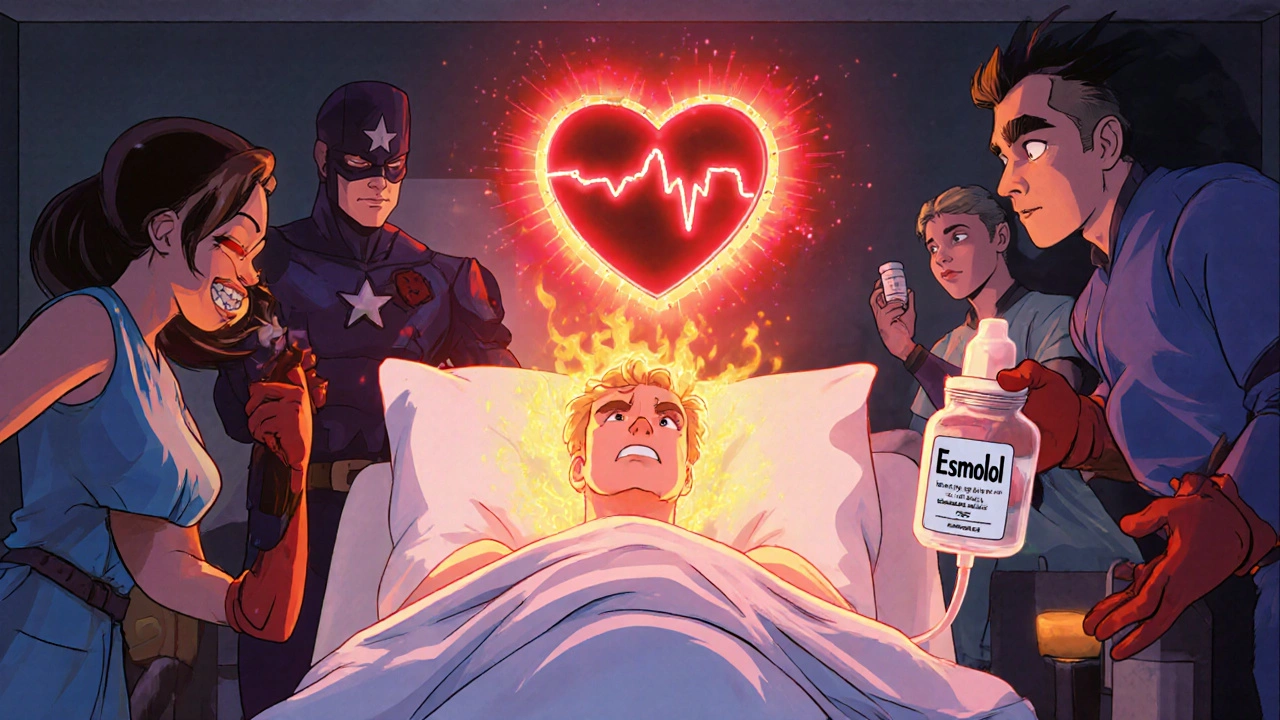What Is Hyperthyroidism?
Hyperthyroidism happens when your thyroid gland makes too much thyroid hormone. This hormone controls how your body uses energy, so when there’s too much, your body goes into overdrive. You might feel your heart racing, your hands shaking, or you’re sweating even when it’s cool. Weight loss despite eating more, trouble sleeping, and feeling anxious or irritable are common signs. It’s not just feeling "wired"-this is a real medical condition that affects about 1.2% of adults in the U.S., and women are five to ten times more likely to get it than men.
The most common cause is Graves’ disease, an autoimmune disorder where your immune system accidentally attacks your thyroid and tells it to overproduce. Other causes include toxic nodules-lumps in the thyroid that act like little hormone factories-and toxic multinodular goiter, where multiple nodules go haywire. Left untreated, hyperthyroidism can lead to heart problems, bone loss, and even a life-threatening crisis called thyroid storm.
Why Beta-Blockers Are Used
Beta-blockers don’t fix the root problem. They don’t stop your thyroid from making too much hormone. But they do something just as important: they calm down the symptoms your body is reacting to. Think of them like a fire extinguisher for the symptoms, while other treatments work on putting out the fire itself.
When thyroid hormone levels are high, your body acts like it’s running on adrenaline all day. Your heart pounds. Your hands tremble. You feel nervous, hot, and restless. Beta-blockers block the effects of adrenaline on your heart, lungs, and muscles. That means your heart rate slows, your tremors lessen, and your anxiety eases. Many people feel better within hours of taking their first dose.
Which Beta-Blockers Work Best?
Not all beta-blockers are the same when it comes to hyperthyroidism. The propranolol is the most commonly used and recommended. Why? Because it’s non-selective-it blocks both beta-1 and beta-2 receptors. That’s important because, at higher doses, propranolol also helps reduce the conversion of T4 (the less active thyroid hormone) into T3 (the powerful, active form). This gives it a slight edge over other beta-blockers.
Other options include:
- Nadolol: Taken once daily, it’s long-lasting and good for people who struggle with remembering multiple doses.
- Esmolol: Used only in hospitals, given through an IV during thyroid storm or severe cases. It works fast and wears off quickly, giving doctors precise control.
- Atenolol: A selective beta-1 blocker, sometimes used for patients with asthma or COPD who still need beta-blockade but can’t tolerate non-selective ones.
Dosing varies. For mild cases, 10-20 mg of propranolol every six hours is common. For more severe symptoms, doses can go up to 40 mg four times a day-or even higher, up to 480 mg daily in extreme cases. The goal isn’t to make your heart rate zero, but to bring it down to a safe, comfortable level-usually under 90 beats per minute.

How Beta-Blockers Compare to Other Treatments
Beta-blockers aren’t the cure. They’re the bridge. The real treatments are antithyroid drugs, radioactive iodine, or surgery.
Methimazole is the first-line antithyroid drug. It stops your thyroid from making excess hormone. But it takes weeks-three to six-to fully work. That’s where beta-blockers come in. While you wait for methimazole to kick in, beta-blockers keep you from feeling awful.
Radioactive iodine (RAI) is another common option. It destroys overactive thyroid tissue. But right after RAI, your thyroid can release a flood of stored hormones, making symptoms worse before they get better. That’s why doctors often keep beta-blockers going for months after RAI, until your hormone levels stabilize.
Surgery (thyroidectomy) is less common but used in cases where other treatments aren’t safe or effective. Beta-blockers are usually given before surgery to reduce heart strain and control symptoms.
Here’s how they stack up:
| Treatment | How It Works | Time to Effect | Side Effects | Used With Beta-Blockers? |
|---|---|---|---|---|
| Propranolol (beta-blocker) | Blocks adrenaline effects | Hours | Low energy, dizziness, cold hands | Yes-first-line for symptoms |
| Methimazole | Reduces hormone production | 3-6 weeks | Rash, liver issues, low white blood cells | Yes-often started together |
| Radioactive Iodine (RAI) | Destroys thyroid tissue | Weeks to months | Hypothyroidism (permanent) | Yes-especially in high-risk patients |
| Surgery | Removes part or all of thyroid | Immediate (after recovery) | Hoarseness, low calcium, hypothyroidism | Yes-before and after |
When Beta-Blockers Are Not Safe
Beta-blockers are generally safe, but not for everyone. If you have asthma or severe COPD, non-selective beta-blockers like propranolol can tighten your airways and trigger breathing attacks. In those cases, doctors turn to calcium channel blockers like verapamil or diltiazem. These don’t block beta receptors, so they’re safer for your lungs, while still helping slow your heart rate.
Other red flags include:
- Second- or third-degree heart block
- Severe heart failure
- Very low blood pressure
- Severe bradycardia (heart rate below 50)
Older adults need careful dosing too. Their hearts are more sensitive, and they’re more likely to have other conditions like diabetes or depression, which beta-blockers can worsen. Doctors start low and go slow.
How Long Do You Take Beta-Blockers?
You don’t take beta-blockers forever. They’re a temporary fix. Once your thyroid hormone levels return to normal with antithyroid drugs or after RAI, your doctor will start tapering off the beta-blocker. That usually happens within four to eight weeks.
But if you’ve had radioactive iodine, it might take months for your thyroid to fully settle down. In those cases, beta-blockers may be needed for three to six months-or longer-until your body stabilizes.
Stopping too soon can bring back the racing heart and shaking. Stopping too late isn’t dangerous, but it’s unnecessary. Your doctor will monitor your pulse, blood pressure, and thyroid tests to decide when it’s safe to stop.

What About Thyroid Storm?
Thyroid storm is rare-but deadly. It’s a medical emergency where your thyroid hormones spike so high that your body shuts down. You might have a fever over 104°F, confusion, vomiting, and a heart rate over 140. Survival depends on fast, aggressive treatment.
In the ICU, doctors use esmolol through an IV, starting at 50-100 micrograms per kilogram per minute. This drug works in seconds and wears off in minutes, so doctors can adjust it precisely. They also give high-dose antithyroid drugs, steroids, and cooling measures. Beta-blockers are essential here-not optional.
Studies show that starting beta-blockers within 24 hours of diagnosis cuts emergency visits by nearly 40%. The sooner you treat the symptoms, the less likely you are to crash.
What to Expect During Treatment
Most people feel better quickly. Your heart stops pounding. Your hands stop shaking. You sleep through the night. But side effects can happen:
- Fatigue or dizziness
- Cold fingers or toes
- Worsening depression (rare)
- Low blood sugar awareness (if you have diabetes)
Don’t stop taking them suddenly. If you do, your heart rate can rebound dangerously. Always taper under your doctor’s guidance.
Regular blood tests are key. You’ll need thyroid function tests at 6 weeks, then every 3 months until stable. Your doctor will also check your liver and white blood cell count if you’re on methimazole.
Bottom Line
Hyperthyroidism doesn’t go away overnight. But you don’t have to suffer while you wait. Beta-blockers like propranolol give you back control-fast. They’re not the cure, but they’re the most important tool you have for feeling human again while your real treatment takes effect. Work with your doctor to find the right dose, monitor your symptoms, and never stop them cold turkey. With the right plan, you’ll be back to normal long before you think possible.

